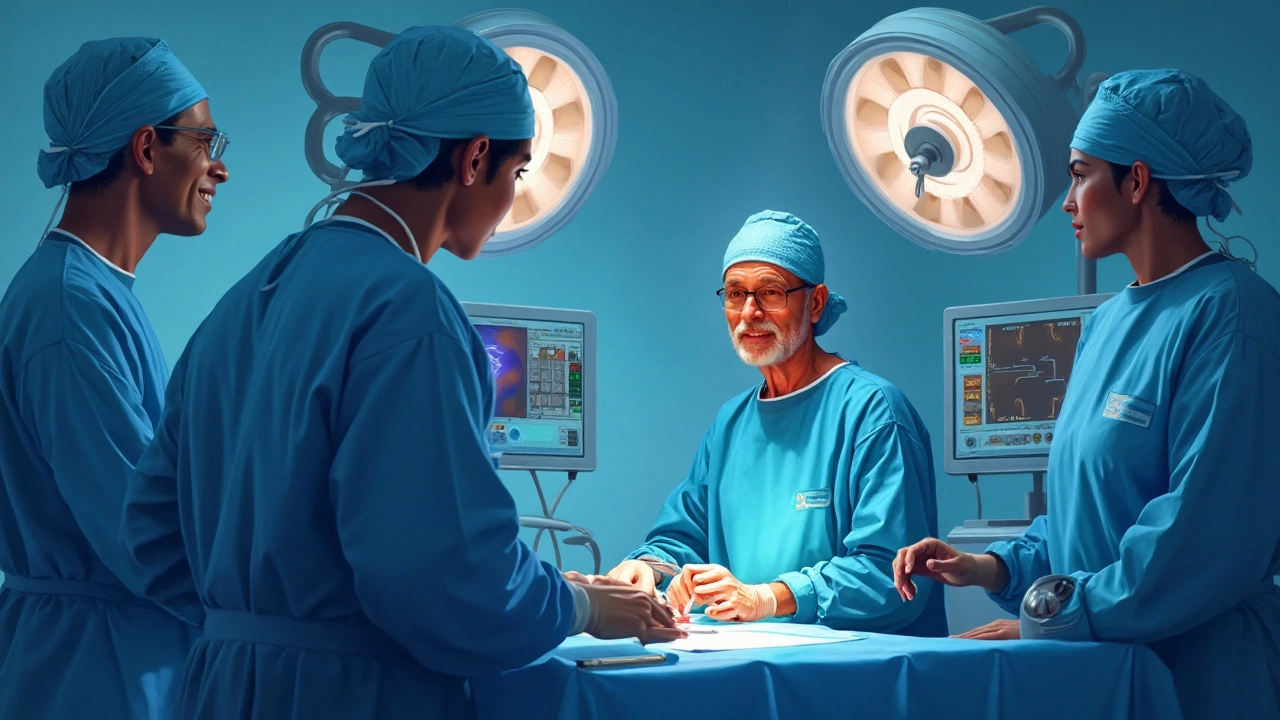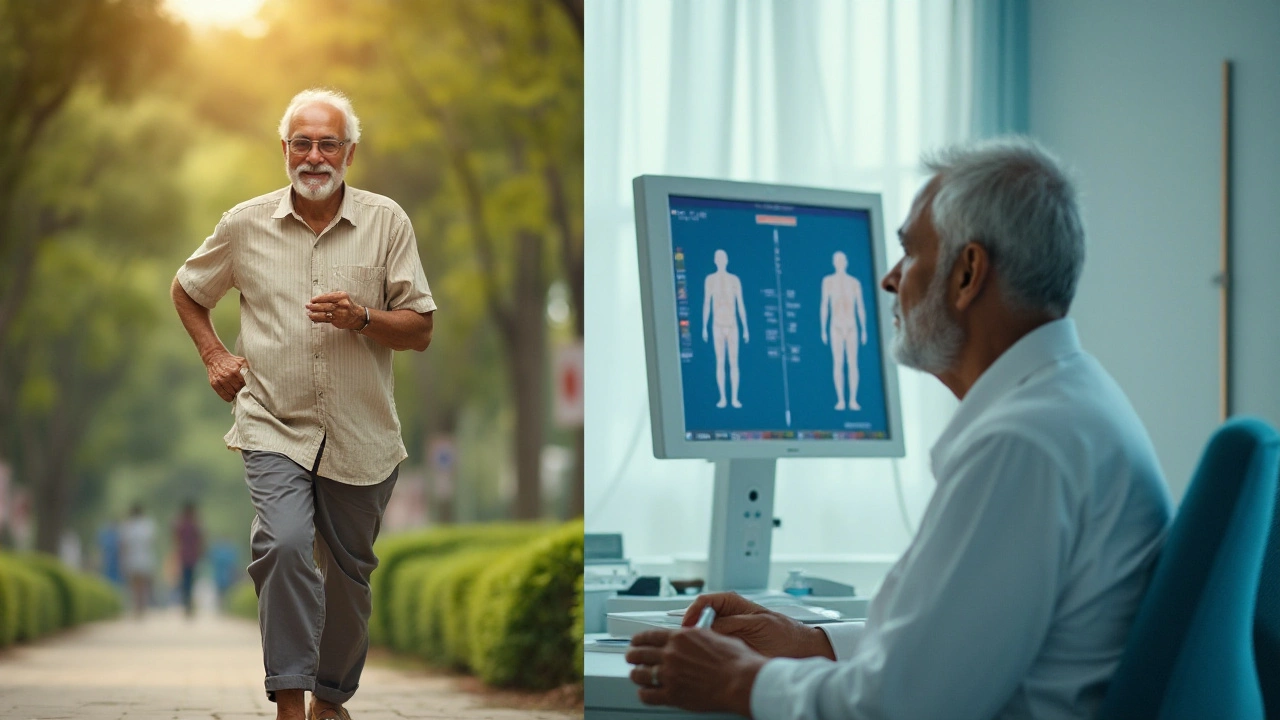
Open heart surgery is a significant medical procedure necessitated by various heart conditions. As individuals age, their eligibility for such surgeries often prompts questions. It's not as simple as putting an age cap on the procedure. Rather, doctors weigh many variables before reaching a decision.
The body's resilience, the presence of other health conditions, and the projected benefits play roles in the surgical decision-making process. While there's a perceived notion about age limitations, the reality is nuanced and personal health assessments are central to the conversation. By exploring these complexities, one gains insight into how age intersects with medical possibilities, offering hope and clarity for those potentially facing this pivotal health choice.
- Understanding Open Heart Surgery
- Factors Influencing Surgical Decisions
- Age and Risk Assessment
- Alternatives to Open Heart Surgery
- Future Advances and Considerations
Understanding Open Heart Surgery
Open heart surgery, a procedure requiring intricate precision and expertise, involves the heart being opened to address severe cardiovascular concerns. Typically, this procedure takes place in cases involving coronary artery bypass surgery, heart valve repairs, or congenital heart defects. Remarkably, this life-saving surgical intervention has been around since the mid-20th century, with innovations continually improving outcomes. The evolution of techniques has reduced common complications and enhanced recovery, expanding what was once a daunting undertaking into a relatively routine procedure.
During the surgery, patients are usually placed on a heart-lung machine. This machine temporarily takes over the function of the heart and lungs, circulating blood and oxygen through the body while the surgeon operates. It allows the heart to remain still, providing an environment in which delicate work can be performed effectively. Despite its complexity, the procedure's success largely hinges on factors like the conditions being treated, the patient's overall health, and the expertise of the surgical team.
It's fascinating to note that open heart surgery not only remedies blockage but can also repair critical parts of the heart that have been damaged over time. The precision of modern surgical tools and techniques have drastically improved the prospects of older adults who may need these operations. According to the American Heart Association, survival rates have increased significantly over recent decades, thanks to advancements in surgical technology and postoperative care.
"Open heart surgery has revolutionized cardiac care and continues to save countless lives each year," states Dr. John McWilliams, a leading cardiologist who has been at the forefront of major cardiac surgical studies.
While each surgery involves risks, careful screening beforehand aims to minimize complications. Pre-surgical evaluations assess a host of factors including lung function, blood pressure, and overall cardiovascular health. This comprehensive approach ensures that the benefits of undergoing such an operation outweigh the potential risks. With a broader understanding of these complex dynamics, patients and their families can engage in informed discussions with their medical team, cultivating hope and clarity in what may otherwise be a challenging time.
Factors Influencing Surgical Decisions
The decision to proceed with open heart surgery is meticulous and multi-faceted. Physicians must consider a landscape of variables, each contributing uniquely to the final verdict. First and foremost, the patient's overall health status stands as a significant determinant. Beyond the presence of the heart condition itself, doctors meticulously evaluate comorbid conditions such as diabetes, kidney issues, or lung diseases which might complicate recovery or surgery itself. Medical experts often contend that these comorbidities could pose risks as significant as age, underlining their influence in the decision-making process.
An area that commands attention is the functionality of the patient's heart. A key question healthcare providers seek to answer is whether the patient's heart is robust enough to endure and recover from surgery. Evaluating this involves comprehensive tests including echocardiograms and stress tests to measure heart strength and resilience. Interestingly, age is not directly prohibitive; many studies emphasize that biological age can offer more insight than chronological age. As one study notes, "The most important factors are the biological age and physiological condition of the patient," indicating that chronological age often comes second to overall health fitness.
Beyond individual health metrics, the specific type of heart disease or condition needing surgical correction plays a critical role. Some conditions undeniably require surgical intervention, while others might be managed with less invasive methods. Aortic valve replacement and coronary artery bypass grafting are common procedures tested against potential risks and benefits. A detailed risk-benefit analysis becomes necessary; the surgical team weighs the immediate and long-term advantages against the attendant surgical risks.
Patient and family preferences can also impact surgical decisions. Conversations between healthcare providers and patients (and, if necessary, their families) become essential to understand expectations, objectives, and concerns. Some individuals may prioritize quality of life over longevity, shaping the course of action. These discussions often delve deep into the patient’s own values, necessity for independence, and desired lifestyle post-surgery. In light of this, a patient-centered approach rooted in informed consent and education marks a cornerstone in surgical planning.
Technological advancements and availability of adept surgical teams are also pivotal. Not all hospitals may be equipped to handle the complexities of an open heart surgery, potentially influencing where and when surgery occurs. Moreover, ongoing advances in medical technology continue to shift the frontiers of what's possible, influencing surgical candidacy. Many facilities incorporate robotic and minimally invasive technologies, which may offer safer alternatives for older or frailer patients. Such innovations present fresh optimism where traditional surgery might pose infernal risks.
Finally, it is essential to consider recovery and rehabilitation capabilities. Post-surgery, the journey involves its own hardships, and doctors often evaluate whether the patient can cope with rehabilitation demands. Support systems, both familial and healthcare-related, could determine success rates of recovery, nudging the surgical decision one way or the other. This holistic approach, utilizing an interwoven understanding of health, patient preferences, technology, and community support demonstrably embodies the essence of modern heart surgery planning.

Age and Risk Assessment
The decision to perform open heart surgery on elderly patients is deeply complex and inherently personalized. Doctors must evaluate numerous factors, with age being only one piece of the intricate puzzle. As life expectancy increases, the traditional boundaries once associated with age in such high-stakes procedures are continuously being reexamined. Medical professionals often put more emphasis on the individual's overall health status, the potential risks versus rewards of the surgery, and the patient's quality of life after surgery than on their chronological age alone. It's not uncommon for a fit 80-year-old to handle surgery better than someone decades younger with a multitude of health issues.
Among these assessments, risk factors such as diabetes, kidney disease, and the presence of other cardiovascular conditions are critical. Doctors generally conduct a comprehensive evaluation, employing a combination of diagnostic tests, including echocardiograms, stress tests, and perhaps even cardiac catheterization, to gauge the heart's function. These assessments intend to chart a clear picture of the patient's cardiac and overall health landscape. Apart from physical tests, the mental well-being and emotional resilience of the patient are essential considerations, as psychological factors can significantly impact recovery times and outcomes.
Assessing Surgical Risks
Medical professionals often use scoring systems to quantify risks. One known tool in the medical community is the EuroSCORE, which calculates the chance of survival over time based on various health dimensions. While these tools provide useful insights, they are not absolute. Clinical judgment often prevails, taking into account advancements in surgical techniques that now allow procedures under conditions previously thought too risky. Dr. Anna Peterson, a heart specialist at the forefront of geriatric cardiology, mentioned,
"We must look beyond age. Open heart surgery considers the whole person; a biopsycho-social approach is paramount in aging."Such perspectives highlight the evolving nature of surgical candidacy criteria in contemporary healthcare.
Alternative Considerations and Future Directions
In some cases, doctors might explore less invasive interventions as safer alternatives to traditional surgery, especially if the risks outweigh the benefits. Techniques such as percutaneous procedures, which involve smaller incisions or even non-surgical options like medication management, are paving the way for tailored treatment plans that take the individual's entire context into account. As laboratory research and technology evolve, the potential to refine cutting-edge solutions offers promise. Nevertheless, for now, determining surgical eligibility in older patients remains an artful balance, requiring thoughtful consideration, patient-centric discussions, and an unwavering focus on improving life quality while respecting medical boundaries.
Alternatives to Open Heart Surgery
When individuals face the daunting prospect of undergoing open heart surgery, exploring alternatives can be a source of comfort and can potentially reduce the physical stress involved. As medical technology advances, many less invasive techniques have been developed, offering viable solutions that might suit certain candidates better than traditional surgery, especially for those of advanced age or with complications.
One of the most popular alternatives is the transcatheter aortic valve replacement (TAVR), which has seen increasing use among the elderly. This procedure offers significant benefits by allowing insertion of a new valve without opening the chest, thereby minimizing recovery time and reducing risks associated with bleeding and infection. Though it was initially reserved for patients considered too high-risk for open heart surgery, the success rates and outcomes have expanded its use to broader groups.
TAVR has been noted for offering "comparable outcomes to surgery in high-risk patients," according to a study published in The New England Journal of Medicine.
Another alternative is percutaneous coronary intervention (PCI) or angioplasty. This procedure involves the insertion of a small balloon to open narrowed or blocked blood vessels that supply blood to the heart. Often accompanied by stent placement, PCI provides relief from symptoms of heart disease, such as chest pain, and is performed with less anesthesia, making it a suitable option for many elderly patients.
For instances where valve repair or replacement is required, minimally invasive heart surgery is another path. This involves smaller incisions and aims to reduce trauma to the chest wall. It is associated with shorter hospital stays, quicker return to routine activities, and less pain post-procedure compared to traditional surgery. Such benefits have made it a favorable choice, opening doors to treatment options previously limited by a patient's inability to withstand full open heart surgery.
Additionally, medication and lifestyle changes can serve as powerful strategies in managing certain heart conditions without surgery. In cases of mild to moderate heart disease, interventions such as cholesterol-lowering drugs, blood thinners, and antihypertensives, combined with improved diet and increased physical activity, can help manage symptoms effectively. Engaging in regular exercise, maintaining a healthy weight, and controlling stress are critical factors that potentially delay or altogether prevent the need for surgical interventions.
Innovative approaches in the pipeline show promising prospects. Research in stem cell therapies and biologics aims to regenerate heart tissues naturally, potentially eliminating the need for some traditional interventions. While these are predominantly experimental today, the future holds exciting possibilities that may further reduce dependence on surgical methods.
In making healthcare decisions, it's crucial to have open discussions with cardiologists and surgical teams about these options. Tailored treatment plans, considering personal health histories and preferences, are essential. With a variety of less invasive alternatives available, patients can find pathways to recovery that align with their health needs and lifestyle goals.

Future Advances and Considerations
The field of open heart surgery has been witnessing rapid transformations owing to technological strides and refined medical insights. These advancements offer a refreshing layer of hope, especially when contemplating the implications of open heart surgery for older adults. As the medical community continues to prioritize patient-safety and optimal outcomes, age might transform from being a point of limitation to just another factor among a plethora of considerations. Innovative techniques, such as minimally invasive procedures, are now at the forefront, reducing recovery times and improving the post-operative quality of life. By utilizing sophisticated imaging and robotic assistance, surgeons are achieving precision that minimizes risks associated with traditional surgical methods. Such tools amplify the scope by potentially expanding suitable patient categories.
One leading area of advancement is in the realm of personalized medicine. Tailoring treatment plans based on genetic insights and individual health profiles promises a more targeted, efficient approach. This customization is particularly crucial for older patients who might have varying response patterns to medications or anesthesia. Additionally, stem cell therapy and regenerative medicine are being explored for their potential to repair damaged heart tissues, offering an alternative that might complement or even bypass the need for surgery.
The future might witness a paradigm shift where traditional surgical interventions are supplemented or replaced by these cutting-edge therapies. There's a growing consensus among healthcare professionals that holistic patient assessment, involving both physiological and psychological evaluations, will dictate the path forward. As Dr. Patricia Jones, a cardiothoracic specialist noted,
"Age is a significant factor, but what's paramount is the comprehensive health picture of the patient. We are moving towards an era where heart health can be managed with less invasiveness."
The changing dynamics also emphasize preventive cardiology, aiming to mitigate risk factors before they necessitate surgical intervention. Public health initiatives now focus on lifestyle modifications, educating populations about diet, exercise, and stress management practices. This preventive stance is backed by statistical findings, which indicate that lifestyle changes can decrease the incidence of heart surgeries significantly. Below is a simple representation:
| Intervention | Impact on Heart Surgery Rates |
|---|---|
| Diet Modification | 25% Reduction |
| Regular Exercise | 30% Reduction |
| Stress Management | 20% Reduction |
| Smoking Cessation | 35% Reduction |
Such data-driven approaches are instrumental in crafting policies and programs that might delay or even prevent the need for medical interventions like heart surgery. As we look forward, collaborations between engineers, researchers, and clinicians hold immense promise. They are expected to yield novel devices, pharmaceuticals, and techniques that will alter how we treat heart conditions, pushing the boundaries of what's deemed possible today. The integration of artificial intelligence and machine learning in medical diagnostics and decision-making tools is expected to hone the accuracy of predicting surgical outcomes, allowing physicians to craft more precise, patient-specific plans. With these developments on the horizon, the future of cardiac care looks poised for a transformation, firmly anchoring hope that transcends the boundaries traditionally set by age.

Write a comment